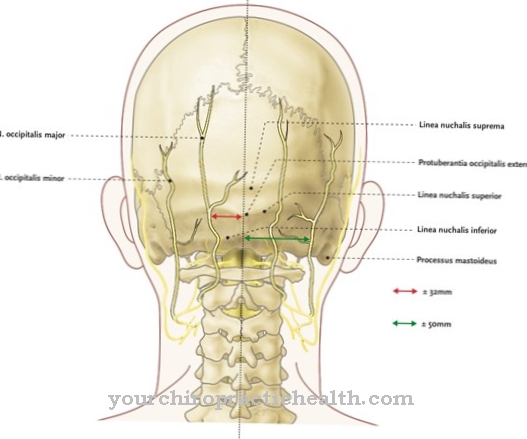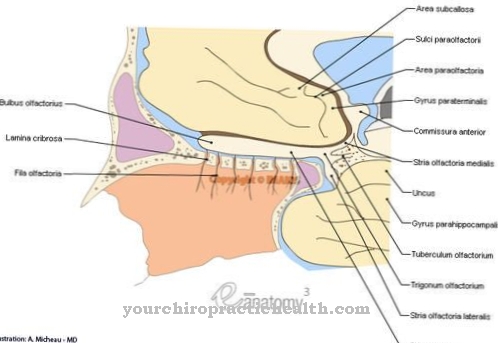muscle fibers form the cellular basic and working unit of all human skeletal muscles. They can have a length of less than 1 mm to 50 cm with a thickness of about 0.01 to 0.2 mm. Several muscle fibers become muscle fiber bundles which - also combined into several - form the muscle in its entirety. The multinucleated muscle fibers can respond to electrical nerve stimuli with contraction or relaxation. There are several different types of muscle fibers that differ in reaction speed, fatigue behavior and energy metabolism.
What are muscle fibers?
As muscle fibers are the striated muscle cells that make up the skeletal muscles. Other common names are Muscle fiber cells or Myocytes. The multinucleated muscle fibers reach a length of a few mm to 50 cm and a diameter of 0.01 to 0.2 mm. Several muscle fibers aligned in parallel are combined to form muscle fiber bundles and enveloped by a membrane.
The actual contractile function is performed by myofibrils, several hundred of which are present in each muscle fiber. A contraction of the muscle is achieved by sliding actin and myosin filaments parallel to each other, without them shortening themselves. For the fulfillment of different tasks of the muscles such as speed strength with minimal Reaction time or endurance, different muscle fiber types can be distinguished, which differ in reaction time and in their energy metabolism.
Fast-reacting muscle fibers that tire quickly work in the anaerobic area, while the muscle fibers, which are characterized by longer reaction times, mainly work in continuous aerobic operation. The distribution of the different muscle fiber types within a muscle is largely genetic and it is very likely that it cannot be changed by strength and endurance training.
Anatomy & structure
Muscle fibers are the cellular building blocks of the striated skeletal muscles. It is a syncytium, a fusion of many individual cells, whose cytoplasm and cell nuclei are preserved and become part of the new large cell. There can be up to 40 cell nuclei per mm in a muscle fiber. Each individual muscle fiber contains several hundred myofibrils, which are composed of sarcomeres that are only about 2 µm long.
The sarcomeres resemble tiny “compartments” in which parallel actin myofilaments and, each laterally offset, myosin motor proteins are located. They are arranged one behind the other so regularly that the typical horizontal stripes can be seen in polarized light. In a muscle fiber with a length of 10 cm there are cica 40,000 sarcomeres in a row. When a corresponding action potential is received, the actin and myosin filaments slide into each other and lead to a shortening of the muscle cell.
Each myofibril and its associated organelles are enveloped by a membrane, the sarcolemma. To increase mechanical strength, myofibrils also contain connective tissue fibers that have grown on the basement membrane. So-called muscle spindles or proprioceptors, which are embedded between the muscle fibers and inform the central nervous system (CNS) about the current state of contraction of the muscle via afferent nerve fibers, take on a very important function.
Function & tasks
Skeletal muscles can only achieve their main functions such as stabilizing the body, moving individual limbs and releasing heat to the body through the interaction of their individual muscle fibers. In order to ensure that all muscle fibers shorten almost at the same time during a muscle contraction, all muscle fibers must receive the action potential for contraction (almost) at the same time, because otherwise there would be point-like muscle tension and relaxation.
The sarcolemma is responsible for the transmission of the contraction command to all muscle cells of a certain muscle, which offers the anatomical prerequisites for this due to its many invaginations in the myofibrils. The extremely fast reacting FT fibers (fast twitch), which appear pale due to their low content of myoglobin and mitochondria, are also known as white muscle fibers. You develop a high strength potential, but tire quickly. The body needs these types of muscle fibers for escape or attack reactions as well as for high jumping or striking power.
In contrast to this are the so-called slower ST fibers (slow twitch), which are also called red muscle fibers because of their high content of myoglobin and mitochondria. You develop less strength, but work aerobically and tire much more slowly. If the body is hypothermic, muscle cells of the skeletal muscles can be induced by the autonomic nervous system to voluntarily uncontrollable chills (muscle tremors), which ultimately converts glucose into heat and the body temperature can rise again.
You can find your medication here
➔ Medicines for muscle weaknessIllnesses & ailments
Diseases and complaints in connection with muscle fibers can occur either through direct diseases and inflammation in the muscle fibers, or through lesions on the innervating nerves or on their superordinate nerve nodes. In the former case there are a number of possible myofibrillary myopathies and in the latter case a neuromuscular disease.
Direct mechanical damage to muscle fibers can result from a ruptured muscle fiber if the muscle is stressed too much at certain points. Usually several muscle fibers or even entire muscle fiber bundles are affected. Myofibrillary myopathies manifest themselves in progressive muscle weakness and muscle wasting, which can be traced back to one or more genetic defects. While muscle tremors in the form of chills are to be assessed as a normal process, muscle tremors (tremor) can also be triggered by a wide variety of neurological diseases. A distinction is made between rest, action, movement or intention tremors.
The different types of tremor provide initial clues as to the type of possible lesions present in the brain. Serious impairment of muscle fibers can be caused by a disease of the motor neurons. Either the first (primary) motor neurons, whose axons originate in the motor cortex, are affected, or the second motor neurons, which originate from the spinal cord. Amyotrophic lateral sclerosis (ALS) belongs to the group of motor neuron diseases. It announces itself through muscle weakness or muscle stiffness and takes a different progressive course.









.jpg)



.jpg)



.jpg)







.jpg)


